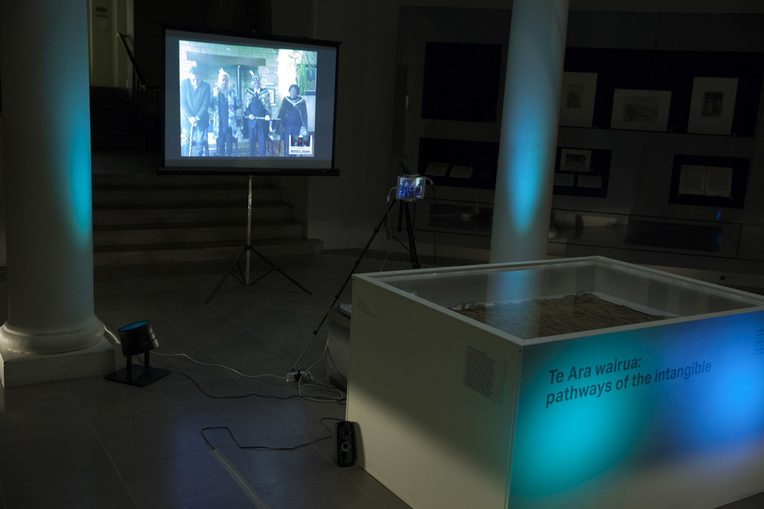A Dissonant Digital Ontology
From the Series: Digital Ontology
From the Series: Digital Ontology

I propose we think about a digital ontology from the perspective of how things work, rather than how things are. What does it mean for conversations about what there is to take place within a representational field that might break down or fail at the last minute, diminishing our potential to access the world? How can software and code as both representational forms and performative media intervene in the tensions between epistemology and ontology that underpin anthropological discussions about multiple ontologies?

My comment here emerges from a project, Te Ara Wairua: Pathways of the Intangible, which was a collaboration between myself, Stuart Foster, Kura Puke—both of Massey University— and Te Matahiapo Research Organization in Aotearoa New Zealand. Our research has explored the tensions between utopian discourses of connection and digital mediation, and how we create, define, and use digital objects in practice. We have tracked social relations (or whakapapa in Māori; “the web of interconnectivity”) across digital objects, screens, software platforms, and within cellular and broadband networks.
Te Ara Wairua, in Māori, means “pathways of spiritual or intangible energy.” Our project focuses on a Kakahu, a cloak of finely woven flax, wool, and dog hair, now held in University College London’s (UCL) Ethnography Collection. With backgrounds in designing virtual environments and a longstanding practice of connecting to Māori cultural treasures (taonga) through light and sound, Kura and Stuart’s intention was to “bring the UCL cloak into the light” and to bathe it with energy from Aotearoa, New Zealand. Working closely with the Taranaki-based Te Matahiapo Research Organization, they wanted to connect the cloak to a living Māori community. Throughout our project the term wairua, meaning “spiritual energy,” has been used as both an analogous and an encompassing term to describe the digital. Just as digital communication media largely exists as wireless waves of information, transmitted all around us, so too are taongaunderstood to create energetic networks of connectivity across space and time. The connection of this cloak, through broadband and cellular activity, to people both in London and New Zealand was therefore not framed as something new, but as a continuation of the kind of work that taonga are supposed to do: to connect people, activate networks of knowledge and sociality, and maintain those links.
I collaborated with Kura and Stuart for nearly a year before they came to England in June 2014. On June 17, we created a ceremonial environment (powhiri) in UCL’s Octagon gallery. Representatives of UCL Anthropology; Museums and Collections; and Ngati Ranana, the London Māori club, were ushered into a space in the gallery by Te Matahiapo with a karanaga (call), to stand before the cloak and before the elders who then spoke with chants (karakia) and song (waiata) to us. Instead of the traditional hongi (sharing of breath), we breathed onto a gift (koha), a woven basket from Vanuatu, which was later returned to Taranaki. The event contained the usual tensions that activate any ritual and make it crackle with social energy. We were unable to hear all of the words of the invocations in London due to bad cellular connectivity, even though we could be heard perfectly in New Zealand.
As an interaction designer, Stuart started from the assumption that the technology in this project should be invisible, allowing us the impression of an unmediated connection between London and Taranaki. He talked about how the medium (FaceTime, iPads and iPhones) should disappear, facilitating a pure connectivity that might be able to overwrite the history of the cloak that had placed it thousands of miles away from its communities of origin. In later conversations we wondered about the significance of the lack of sound, or, as we experienced it from our end, the stilted quality of the connection. Perhaps the “failings” of technology at the event evoked exactly the situation we were in: a brave attempt to recreate a connection that can never be fully salvaged; to work across a distance that is still present, that still remains; to work across interpretive gaps in language and cosmology, within the interstices of colonial history. We are still struggling to reconcile the holism of Māori understandings of taonga as spiritual connectors with the more dissonant experience of colonial collecting.
At the end of several weeks of exhibiting the cloak in UCL’s North Lodge, Te Urutahi—in another FaceTime session, also with a bad cellular connection—gave the cloak a name: Tuktuku Roimata. The name evokes the tears of the ancestors from the spiritual realm interwoven and connecting us with the physical realm through the Korowai. These tears recognize the absence of the cloak from a known whakapapa (genealogy) and also celebrate the emergence of new webs of connection. This name captures the celebratory qualities of connection brought forth by the communicative possibilities of digital technologies, even as it performs a lament for what cannot be reconnected.
Lev Manovich (2013, 15) considers software to be “a layer that permeates all areas of contemporary societies” that is increasingly constitutive of all cultural production. Looking ethnographically at how these technologies work (or do not work) in practice exposes the gap between many anthropological theorizations of ontology that extrapolate holistic theories of being from within the representational constraints of language. We can productively explore the analytic confusion between what there is and what we think about what there is within the frame of digital technologies that challenge us to understand the simultaneity and interdependence of worldmaking and representing the world.
Manovich, Lev. 2013. Software Takes Command: Extending the Language of New Media.London: Bloomsbury.